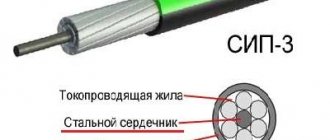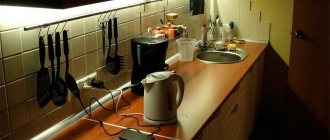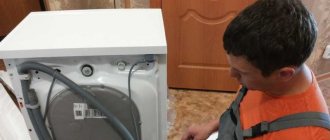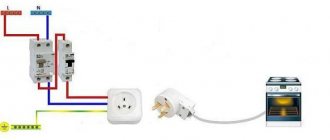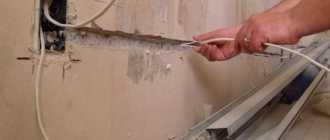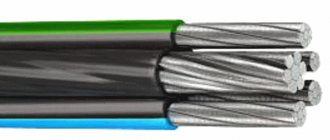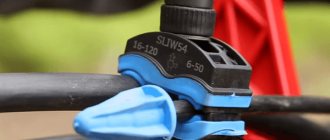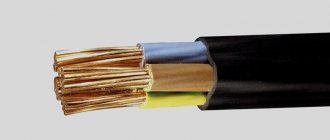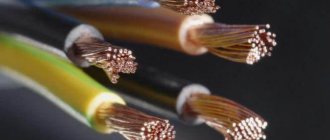How to measure cable cross-section using a ruler or caliper? (protect yourself from being scammed)
Good day, dear readers!
You and I understand that one of the main parameters or characteristics of a wire or cable is the cross-section of the core. And if the cross-section differs from the declared one, then we may have a question: have we been deceived?
About all this and more in this article.
To begin with, I can recommend you this article:
WHY CAN THE SECTION BE LESS THAN DECLINED?
Let's consider several cases:
1. Not so long ago we figured out that a cable or wire can be divided into GOST and TUSH. So, in TU cables the cross-section is most often lower (and in some cases much lower) than declared. That is, for example, it should be 2.5 mm2, but in fact it is 2.0 mm2.
And be prepared for it.
2. In cables and wires certified according to GOST, there may also be discrepancies with the data on paper. And I'll tell you what: this is allowed by the rules. However, the discrepancy in such cases is minimal (approximately 5%).
And this fact does not just “walk among people”, but it is officially documented. GOST 22483-77 paragraph 1.4a:
As we can see, the main parameter here is not the cross section, but the resistance.
3. Well, the third case is that you simply measured the cross section incorrectly. Find out how to do it correctly below.
HOW TO CORRECTLY MEASURE THE CABLE SECTION
Using the cross-section of a cable or wire to measure it will not be enough, since this way you will only get one value: the diameter of the core.
What then is the cross-section of the vein?
The cross-section of the core is the area, not the diameter.
How to calculate?
And in this case it is calculated very simply - according to the formula:
Or you can simplify this formula as follows: just square the diameter, and then multiply it by 0.785 (this is Pi divided by 4).
STEP-BY-STEP PROCESS
Once again, everything is in order:
- We take a caliper and measure the diameter of the core.
- Let's square it: that is, multiply it by a number equal to the diameter.
- We multiply the resulting number by 0.785.
- In total we get the wire cross-section.
ANOTHER WAY
There is also another option - just use the table:
Here you just need to use a caliper to substitute the value into the table.
Therefore, when measuring the diameter of a cable with a cross-section of 2.5 mm, you will see a mark of 1.8 mm on the measuring tool.
Now you know how to measure cable cross-section and can protect yourself from fraud!
If the article was useful, please like and subscribe to the channel!
There is still a lot of interesting and useful things ahead!
Source
Undersized wire cross-section - what is the danger?
So, let's consider the dangers that await us when using low-quality wires in everyday life. It is clear that the current characteristics of current-carrying conductors decrease in direct proportion to the decrease in their cross-section. The load capacity of the wire decreases due to the reduced cross-section. According to the standards, the current that the wire can pass through is calculated. It will not collapse if less current passes through it.
The resistance between the cores decreases if the insulation layer is thinner than required. Then, in an emergency situation, when the supply voltage increases, a breakdown may occur in the insulation. If, along with this, the core itself has a reduced cross-section, that is, it cannot pass the current that, according to standards, it should pass, the thin insulation begins to gradually melt. All these factors will inevitably lead to a short circuit and then to a fire. A fire occurs from sparks that appear during a short circuit.
Let me give you an example: a three-core copper wire (for example, with a cross-section of 2.5 sq. mm.), according to regulatory documentation, can pass 27A through itself for a long time, usually 25A is considered.
But the wires that come into my hands, produced in accordance with the specifications, actually have a cross-section of 1.8 square meters. mm. up to 2 sq. mm. (this is with the stated 2.5 sq. mm.). Based on the regulatory documentation, the wire has a cross-section of 2 square meters. mm. can carry a current of 19A for a long time.
Therefore, if such a situation happens that along the wire you have chosen, which supposedly has a cross-section of 2.5 square meters. mm., the current designed for such a cross-section will flow, the wire will overheat. And with prolonged exposure, the insulation will melt, followed by a short circuit. Contact connections (for example, in a socket) will collapse very quickly if such overloads occur regularly. Therefore, the socket itself, as well as the plugs of household appliances, may also be subject to melting.
Read also: How to make an electric screwdriver from a screwdriver
Now imagine the consequences of all this! It’s especially disappointing when a beautiful renovation has been made, new appliances have been installed, for example, an air conditioner, an electric oven, a hob, a washing machine, an electric kettle, a microwave oven. And so you put the buns in the oven to bake, started the washing machine, turned on the kettle, and even the air conditioner, since it became hot. These switched on devices are enough to cause smoke to come out of junction boxes and sockets.
Then you will hear a pop, which is accompanied by a flash. And after that the electricity will disappear. It will still end well if you have circuit breakers. What if they are of low quality? Then you won't get away with a bang and a flash. A fire will start, accompanied by sparks from the wiring burning in the wall. The wiring will burn in any case, even if it is tightly walled under the tile.
The picture I described makes it clear how responsibly you need to choose wires. After all, you will use them in your home. This is what it means to follow not GOSTs, but TUs.
How to determine the cable cross-section based on the diameter of the core?
Views: 4,111
If the manufacturer does not cheat, then the cross-section of the conductors in the cable must correspond to the parameters on the cable marking. For example, if the cable insulation indicates that the cable is 3 x 1.5, then the cross-section of the conductors should be exactly 1.5 mm2. But sometimes it happens that the actual size may differ by 10-20%, and sometimes more. And this threatens to overheat the cable and burn the insulation, with all the ensuing consequences. Therefore, before purchasing, it is advisable to measure the diameter of the cable cores to determine its cross-section. We will find out further how to find out the wire cross-section by diameter.
What is the cable cross-section
Cable cross-section is the cut area of the cable conductor without taking into account the winding and insulating layer. Typically, all cables and wires have a round cut and one core. In this case, the cross-sectional area can be found using the formula for the area of a circle. If there are several current-carrying wires, then the cross-section will be the sum of the cross-sections of all wires and cores.
An even cut of the wire, which is a cross-section
For your information! The cross-sectional area is subject to standardization in all countries. States of the former USSR and Europe have the same standards. In Russia, the PUE (Electrical Installation Rules) serves as a regulatory document.
The area of a circle is the cross section
Calculation by formula
The main geometric indicator of a conductor is its cross-sectional area. The throughput of the electrical conductor, and, consequently, its performance characteristics, which affect safety and durability, depend on this size. As mentioned above, this parameter is easily determined after measuring the diameter of the conductor. To do this, use the formula to determine the area of a circle:
Ready-made tables are a great way to quickly determine the cross-sectional area of a wire, but to be one hundred percent sure of the obtained value, it is better to check and calculate it yourself.
What is the difference between cross section and diameter?
The cross section in the shape of a circle must have a diameter. The section itself is a cut of a cable or any other object at right angles to the longitudinal axis. The diameter is a chord, that is, a segment that connects two points on a circle and passes exactly through its center. Not only a circle or circle has a diameter, but also a sphere or ball. These quantities have little in common, since one determines the distance, and the other the area.
It is difficult to calculate the area of such a cable on your own.
Note! The section is always used in practice for volumetric bodies, and a cable or wire is a volumetric object that is most often made in the form of a long cylinder (if divided into parts) that has a cross section. Its diameter can also be determined, but it so happens that it is the area that is indicated.
You might be interested in this All about SIP-4 wire
Options by definition
There are several ways to determine the cable cross-section. The need for this usually arises during electrical installation work, when it is necessary to check the existing conductor for compliance with the application standards for a particular area. For example, a person may be doing wiring that requires a cable with a cross-section of at least 1.5 mm. He will need to check his wire for compliance with these conditions, since otherwise, overheating of cables and connections, failure of household appliances and even a fire are possible.
Before measuring, remove the insulating layer
Important! If the conductor has one core, then measurements are made directly on it. It is necessary to untangle one wire from the wire coil, clean it of insulation, and only then take measurements.
Circle area formula
To calculate the cross-sectional area of a round wire through the radius, you need to multiply its square by the number Pi. In practice, it is much easier to determine the diameter and divide it by 2. Based on the measurement methods, the following methods for calculating the cross-section can be distinguished.
By diameter using a caliper or micrometer
The most popular measurement method is to determine the diameter using a caliper or micrometer. Such devices allow you to measure the diameter as accurately as possible, and then multiply half of it by the number Pi.
To operate, you only need a wire and the device itself. The process looks like this:
- Move the micrometer lock to the “Open” position.
- Unscrew the handle of the device to a distance that will be sufficient to insert the conductor between the probes.
- Insert the wire into the probes and twist it with a special hand-held device until a cracking sound is characteristic of the device.
- Record the diameter readings on the appropriate scale.
- Unscrew the handle and remove the wire.
A significant advantage of this measurement method is that it allows you to determine the diameter and, as a consequence, the cross-section of any round conductor. Moreover, it can be connected to the network and actively work in one or another electrical device.
Using the caliper is very convenient
Note! The disadvantage of this method is that the devices are quite expensive, and there is no point in buying them for one or two uses.
By diameter using a pencil or pen
This method is based on the use of any ton object on which a wire core can be wound. Typically, a pen, pencil or felt-tip pen is used as such an object. The wire is wound around it in the form of a spiral with the rings compressed as tightly as possible. To eliminate inaccuracies, the insulation is removed along the entire length of the conductor under test.
You may be interested in this Features of duralight
All windings have the same width and thickness, so it is necessary to compress them as much as possible and determine the total length using a ruler or centimeter. Next, this value is simply divided by the number of winding rings. The more turns there are, the more accurate the result will be in the end.
Formula for wire cross-section by diameter
So, I would like to summarize all of the above. If there are those among you who did not read the article before this paragraph, but simply skipped over, I repeat. Cable and conductor products often lack information about the standards according to which they were manufactured. Ask the seller, according to GOST or TU. Sellers sometimes cannot answer this question themselves.
We can safely say that wires manufactured according to specifications in 99.9% of cases have not only a reduced cross-section of current-carrying conductors (by 10-30%), but also a lower permissible current. Also in such products you will find thin external and internal insulation.
If you have visited all the stores and have not found any wires produced in accordance with GOST, then take a wire with a reserve of +1 (if it is produced in accordance with the technical specifications). For example, you need a 1.5 sq.m. wire. mm., then you should take 2.5 sq. mm. (released by TU). In practice, its cross-section will be equal to 1.7-2.1 square meters. mm.
Thanks to the cross-sectional reserve, a current reserve will be provided, that is, the load may be slightly exceeded. So much the better for you. If you need a wire with a cross-section of 2.5 sq. mm., then take one with a cross section of 4 sq. mm., since its actual cross-section will be equal to 3 sq. mm.
So let's get back to our question. The conductor has a cross section in the form of a circle. Surely, you remember that in geometry the area of a circle is calculated using a specific formula. It is enough to substitute the resulting diameter value into this formula. After making all the calculations, you will get the wire cross-section.
- π is a constant in mathematics equal to 3.14;
- R – radius of the circle;
- D is the diameter of the circle.
This is the formula for calculating the cross-section of a wire by diameter, which many people are afraid of for some reason. For example, you measured the core diameter and got a value of 1.8 mm. Substituting this number into the formula, we get the following expression: (3.14/4)*(1.8)2=2.54 sq. mm. This means that the wire whose core diameter you measured has a cross-section of 2.5 sq. mm.
Calculation of a monolithic core
When you go to the store to buy wire, take a micrometer or caliper with you. The latter is more common as a wire cross-section measuring device.
I’ll say right away that calculate the cable cross-section by diameter for the VVGng 3*2.5 mm2 cable from three different manufacturers. That is, the essence of all the work will be divided into three stages (this is only for monolithic wire). Let's see what happens.
To find out the cross-section of a wire (cable) consisting of one wire (solid core), you need to take a regular caliper or micrometer and measure the diameter of the wire core (without insulation).
To do this, you need to first clear a small section of the wire being measured from insulation, and then begin measuring the current-carrying conductor. In other words, we take one core and remove the insulation, and then measure the diameter of this core with a caliper.
Example No. 1. Cable VVG-Png 3*2.5 mm2 (manufacturer unknown). The general impression was that the cross-section immediately seemed too small, so I took it for experiment.
We remove the insulation and measure with a caliper. I got a core diameter of 1.5 mm. (not enough though).
Now we return to our formula described above and substitute the obtained data into it.
It turns out that the actual cross-section is 1.76 mm2 instead of the declared 2.5 mm2.
Example No. 2. Cable VVG-Png 3*2.5 mm2 (). The general impression is that the cross-section seems to be normal, the insulation is also good, it looks dense and they didn’t skimp on materials.
We do everything in the same way, remove the insulation, measure, we get the following numbers: diameter - 1.7 mm.
We substitute into our formula for calculating the cross-section by diameter , we get:
The actual cross-section is 2.26 mm2.
Example No. 3. So the last example left is cable VVG-Png 3*2.5 mm2, manufacturer unknown. The general impression is that the cross-section also seemed underestimated, the insulation is generally removed with bare hands (no strength at all).
This time the core diameter was 1.6 mm.
The actual cross-section is 2.00 mm2.
I would also like to add to today’s manual how to determine the cross-section of a wire by diameter using a caliper, another example, VVG 2*1.5 cable (I just had a piece lying around). I just wanted to compare, the sections of the 1.5 format are also underestimated.
We do the same thing: remove the insulation, take a caliper. The resulting core diameter was 1.2 mm.
The actual cross-section is 1.13 mm2 (instead of the stated 1.5 mm2).
Calculation without calipers
This calculation method is used to find the cross-section of a wire with one core. In this case, no measuring instruments are used. Undoubtedly, the use of a caliper or micrometer for these purposes is considered the most optimal. But these tools are not always available.
In this case, find a cylindrical object. For example, a regular screwdriver. We take any core in the cable, the length is arbitrary. We remove the insulation so that the core is completely clean. We wrap the exposed wire around a screwdriver or a pencil. The more turns you make, the more accurate the measurement will be.
All turns should be positioned as closely as possible to each other so that there are no gaps. We count how many turns we got. I counted 16 turns. Now you need to measure the length of the winding. I got 25 mm. Divide the length of the winding by the number of turns.
- L – winding length, mm;
- N – number of full turns;
- D – core diameter.
The resulting value is the diameter of the wire. To find the cross section, we use the formula described above. D = 25/16 = 1.56 mm2. S = (3.14/4)*(1.56)2 = 1.91 mm2. It turns out that when measured with a caliper, the cross section is 1.76 mm2, and when measured with a ruler, it is 1.91 mm2 - well, an error is an error.
How to determine the cross-section of a stranded wire
The calculation is based on the same principle. But if you measure the diameter of all the wires that make up the core at once, you will calculate the cross-section incorrectly, because there is an air gap between the wires.
Therefore, you first need to fluff up the core of the wire (cable) and count the number of wires. Now, using the method described above, it is necessary to measure the diameter of one vein.
For example, we have a wire consisting of 27 cores. Knowing that the diameter of one vein is 0.2 mm, we can determine the cross-section of this vein using the same expression to calculate the area of a circle. The resulting value must be multiplied by the number of veins in the bundle. This way you can find out the cross-section of the entire stranded wire.
As a stranded wire, PVA 3*1.5. There are 27 individual wires in one wire. We take a caliper and measure the diameter, I got a diameter of 0.2 mm.
Now we need to determine the cross section of this vein; for this we use the same formula. S1 = (3.14/4)*(0.2)2 = 0.0314 mm2 – this is the cross section of one vein. Now we multiply this number by the number of cores in the wire: S = 0.0314*27= 0.85 mm2.
Hello, dear visitors of the Electrician's Notes website.
This article is about how you can independently determine the cable cross-section by diameter.
In my last article about PUNP wire, I told you that I would write a series of articles on how to choose the right brand and buy cables and wires.
Read also: Resanta sai 190 photos
So this article is also directly related to this topic.
Why do we need to determine the cross-section of a cable or wire by its diameter?
And we need this for several reasons.
1. There is no tag on the wire or cable coil
There are situations when a cable or wire coil does not have a tag with its cross-section and other characteristics. Of course, as an experienced electrician who deals with this almost every day, I can determine the cross-section of a wire or cable “by eye.” But to be honest, sometimes it happens that it is very difficult to determine the cross section.
2. Buying wires and cables
The second reason is the purchase of these same wires and cables. You all know, and I have told you about this more than once, that in modern market relations, cable and conductor products “sometimes” do not meet the requirements of modern GOSTs. But we’ll talk about this in more detail in the following articles. If you are interested, sign up to receive notifications about the release of new articles on the site.
So, how to determine the cross-section of a cable or wire based on its diameter?
Method No. 1
The first method is used to determine the cross-section of the cores of a single-wire cable or wire.
To do this, we need to use a regular caliper or micrometer to measure the diameter of the cable core (wire) without insulation. I don’t have a micrometer, but I always have a caliper in my electrician’s tool.
As an example, I will give the determination of the cross-section of the VVGng cable core in two ways. As a result, we compare the results obtained.
This is the cable.
We cut the cable and separate the wires.
We take one vein (I took the blue one) and strip it, i.e. remove the core insulation. To remove insulation, I personally use a stripper Knipex 12 40 200 - I recommend it.
Using a caliper, we measure the diameter of this core.
I found that the diameter of the measured core is 1.8 (mm).
Next, we substitute the resulting diameter value into the formula below for calculating the area of a circle.
The resulting value is 2.54 (mm2) - this is the actual cross-section of the cores of our cable.
Method No. 2
The second method is used to determine the cross-section of the cores of a single-wire cable or wire by its diameter without using a caliper or micrometer. I find this method more complex and time-consuming.
It’s better to use the first method, because... it is simpler and more accurate.
But if there is no caliper or micrometer available, then only the second method remains to be used. For this we need a pencil or pen. I used a pencil, but it's better to use a pen or something stiffer.
Everything is done in the same way.
We cut a cable of arbitrary length and bite off any core (I again took the blue core).
We remove the insulation layer from the wire of this core. And then we wrap the wire around the pencil.
It is better to wind more turns - this way the measurement will be more accurate. We carry out the winding itself in such a way that the turn fits tightly to the other turn (without gaps).
Here's what I got.
Next, we count the number of turns obtained. I got 10 turns.
After this, we measure the length of the winding.
The winding length is 18 (mm).
Next, you need to divide the winding length by the number of turns.
We get 1.8 (mm). This is the required core diameter.
The core diameter of the VVGng cable we are interested in is known. And now, using the formula we already know, we determine its actual cross-section.
Because The diameter of the core using both methods turned out to be the same, then, accordingly, their cross-section is the same.
Method No. 3
The third method is used to determine the cross-section of the cores of a stranded (flexible) cable or wire.
First you need to fluff the vein and count the number of veins in it. Then we proceed similarly to the first method, determining the diameter of one vein using a caliper.
For example, the number of veins in a bundle is 12.
By measuring the diameter of one vein, we obtained a value of 0.4 (mm).
Again, using the formula for calculating the area of a circle, we calculate the cross-section of one vein in the bundle.
Now let’s calculate the cross-section of the entire stranded wire by multiplying the resulting cross-section of 0.125 (mm2) by the number of strands in the bundle.
The resulting value of 1.5 (mm2) is the actual cross-section of the core of the flexible cable or wire.
Method No. 4
The fourth method is used to determine the cross-section of the cores of a stranded (flexible) cable or wire without the use of a caliper or micrometer.
We do all the actions according to method No. 2 described above. The only difference is that one core from the bundle must be wound onto the pencil.
Having determined the diameter of one core from a bundle of flexible cable or wire that interests us, we find its actual cross-section using the algorithm of method No. 3.
PS I tried to clearly demonstrate to you the common methods of determining the cable cross-section by diameter. If you have any questions, ask them in the comments. In the following articles I will tell you what to do with the resulting cross-section of a cable or wire, and how to find out whether it complies with current GOSTs or not.
to the entry “How to determine the cross-section of a cable or wire by its diameter”
Thank you very much for the interesting and informative articles, I came across your site by accident and really liked it. Now a question on the topic, how much does the quality of copper affect the resistance of the wire, that is, is it enough to simply determine the cross-section? I just bought PVC for an extension cord, so little that the actual cross-section is underestimated, and the core itself is somehow hard, it’s very difficult to even roll it up, and the cables also come across where the color of the core and softness are noticeably different.
Yes, of course it does. After all, manufacturers will come up with everything they can to reduce costs at the expense of quality. Sometimes they simply copper-plate an aluminum wire - yes, yes, this happens too. How to determine quality products? A new article on this topic will be published in the next few days. Therefore, for those who have not yet subscribed to new articles, subscribe and a notification about the release of a new article on the site will be sent to your email.
The other day I purchased a PVS 2x2.5 from an unknown manufacturer at a recently opened construction fair. I ordered a bay of 100 meters. I paid 2500 rubles for it. But when the bay at home was next to an extension cord made of real PVA 2x2.5, doubts arose and the need to dispel them. The result of the measurements of the conductors is the diameter of the wire in the core is 0.25 mm (measured both with a micrometer and under a mounting microscope), there are 30 wires in the core. The result was not two and a half squares at all. The calculated value was 1.47 squares. This was also confirmed by the downloaded GOST for the wires, in accordance with which the weight of the coil and the diameter of the sheath were measured... After a difficult conversation, the wire was exchanged back for money. Today I took a different route. I bought two PUGNP 2x2.5 bays from OBI, 50 meters each. , 344090, Rostov-on-Don, st. Dovatora, 152/3. I paid 2118 rubles for these 100 meters. After measurements, it turned out that there were 12 wires in the core, each with a diameter of 0.38 mm. S calculated 1.36 square...Maybe I don’t understand something? Maybe there is a coefficient that turns the total cross-section of a stranded conductor into a higher cross-section of a single-wire conductor, for example due to a larger cooling surface? Or it’s becoming more banal and people’s conscience has simply run out. PS. Just to clear my conscience I visited the nearest construction store - there is a general confusion there with the sections. There are right wires and wrong ones. It's just that I don't have the quantity I need.
The cross-section of flexible (multi-wire) cables and wires is calculated as indicated in the article. Those. You thought correctly.
The question here is a little different. Flexible cables (wires) according to GOST 22483-77 have several classes. And each class has its own requirements for the minimum permissible cross-section. I'll tell you about this soon.
In addition to copper plating of aluminum, I have seen how copper is magnetized from Chinese extension cords.
How to measure wire diameter
To measure the diameter of the wire, a caliper or micrometer of any type (mechanical or electronic) is suitable. It’s easier to work with electronic ones, but not everyone has them. You need to measure the core itself without insulation, so first move it aside or remove a small piece. This can be done if the seller allows it. If not, buy a small piece to test and take measurements on it. On the conductor stripped of insulation, measure the diameter, after which you can find out the actual cross-section of the wire by diameter based on the found dimensions.
Measuring wire diameter with a caliper
Measuring wire diameter with a micrometer is more accurate than with a mechanical caliper
Which measuring device is better in this case? If we talk about mechanical models, then a micrometer. Its measurement accuracy is higher. If we talk about electronic options, then for our purposes they both give quite reliable results.
How to determine whether the parameters match?
As a rule, extreme care on your part allows you to avoid such incidents during the purchase:
- A normal wire must have its marking, which provides the buyer with all the information about the model, operating features, and parameters. If you encounter questionable products, you may find that the product data is not presented in full or is completely missing.
- If the conductor is really good, he must be provided with quality certificates. The technical documentation indicates that it was not only manufactured in accordance with the ND, but also passed the appropriate tests.
- A good wire cannot cost a penny - since the price of materials is quite high, the cheapness should make you wonder if there is some kind of catch in this. If you wish, you can come to the store with a micrometer or caliper and perform a test to clear your doubts.
In order to successfully buy a wire, before purchasing you need to measure the diameter of the wire , otherwise you can become a victim of deception. You will also have to measure the cross-section of the wire if you add a new electrical point on the old wiring, since there may not be a letter marking on it. The information below will help you choose the right method for measuring wire diameter and use it effectively in practice.
At the same time, the question will immediately arise: “What is the point of a company spoiling its reputation?” There may be several explanations for this: But the whole point is that even after making the correct calculations of the wire cross-section, you may still encounter a problem, despite the fact that you buy a wire with the appropriate diameter . An accident may occur due to the fact that the marking of the wires will indicate a cross-section of conductors that does not correspond to the actual one. This may happen as a result of the fact that the manufacturing plant saved on the material, or the company producing this product did not comply with all the characteristics of the product. You can also find wires on the shelves that have no markings at all, which initially casts doubt on their quality.
1. In order to save money. For example, the factory made the wire diameter smaller by only 2 mm. sq. with a 2.5 mm core, which made it possible to win several kilograms of metal per linear meter, not to mention the profit in mass production.
2. As a result of great competition, the company reduces the price of electrical wiring, trying to lure most of the consumers. Naturally, this occurs due to a decrease in the diameter of the wire , which cannot be determined with the naked eye.
Both the first and second options take place in the sales market, so you better play it safe and make your own accurate calculations, which will be discussed further.
How to determine by eye
Experienced electricians can determine the cable cross-section by eye. Each conductor can be easily identified by its type and the characteristics corresponding to this type. It is clear that, for example, VVG wires can only be of certain sections, which differ from each other with a certain pitch. This is regulated by technical manufacturing conditions or state standards.
If a person does not have experience or similar knowledge, then an accurate and developed eye and memory will help determine the cross-section by eye. If a master has ever seen a cable with a cross-sectional area of 1 mm², then, having remembered its dimensions, he can mentally or physically compare other conductors with it and draw conclusions about how much it differs, up or down. This helps when the wires are approximately the same.
Note! If you have a conductor with a cross-section of 0.5 mm² and a thick cable with an area of 5 mm², then it will be difficult to determine the dimensions. Besides, professionals don't work like that. This is dangerous and fraught with negative consequences associated with the wrong choice.
Measuring the cross section by eye is not the best idea
The material discussed how to check the cable cross-section with a caliper and some other methods. Measuring this value using special instruments is one of the most correct decisions, since only they make it possible to determine the indicator as accurately as possible.
Calculation of stranded electrical wire and purchasing tips
To calculate the cross-section of a stranded wire, you need to act a little differently than in the case of a single-core wire. If all the cores are the same, then you need to measure one of them in any way, and then calculate the value using the standard formula. When the value is calculated for one of the cores, their number is calculated and the total cross-section is determined by the formula: S total = n*Si (Si is one core). To determine whether the declared parameters correspond to the real ones, the following points must be taken into account:
- There are markings on the wire that help you find out all the important parameters of a particular conductor. If it is not there, then the quality is questionable.
- When the conductor is of high quality, the seller must have certificates. They say that the wire is made in accordance with ND and has been tested.
- A good wire or cable cannot be cheap, since the materials from which it is made are quite expensive. Therefore, at a low price, it is advisable to double-check its cross-section yourself.
The manufacturer does not always indicate the correct cross-section in the specification. But, it is not difficult to find out the real value for the conductors of an electrical wire, even in the absence of the necessary tools. Available tools are also suitable - ruler, pencil, felt-tip pen, pen, paper. The main thing when using such methods is to know the diameter of the cable being measured, and then the value is subtracted using the classical formula.
Source
Subscribe to the newsletter
When a multi-core cable is used that does not meet the declared characteristics and is not manufactured in accordance with GOST, undesirable consequences may occur. Moreover, you can find cables on sale whose labeling and packaging contain unreliable indicators. The declared cross-section may not correspond to the true figure. It turns out that the core of the cable, purchased taking into account a specific load, cannot cope with the current that it should pass. As a result, the insulation melts. The risk of an emergency, including a short circuit, increases significantly. To prevent this from happening, you need to know how to determine the cross-section of a multi-core cable.
Read also: Converting a three-phase motor into a single-phase one
Features of calculating the cross-section of a single-wire (monolithic) core
So, you purchased a cable with a single-wire core and decided to measure its cross-section. To make this possible, you first need to acquire a caliper, a calculator, an insulation stripper and a utility knife. Set the cross-section to the cable diameter. To do this, do the following:
• Strip the insulation from the cable. • Measure the core diameter (using a caliper). • Remember school geometry, namely the formula that allows you to calculate the area of a circle (circular conductive core):
S = π r2, where π = 3.14 and r is the radius of the core.
Thanks to a caliper, you can only find out the diameter, but what is required is the radius. The formula should be modified. It is known that the radius is half the diameter. The formula will look like this:
S = (π d2)/4, where d is the diameter of the core.
To shorten the formula, you can divide the number π by 4. You will get a standard formula for calculating the cross-section of the core by diameter:
Let us carry out the calculation using the example of the VVG-P 2x1.5 cable, in which the diameter of the cores when measured with a caliper is 1.35 mm. Substitute the value into the formula:
S = 0.785*1.352 = 1.43 mm²
From the calculations it is clear that the actual cross-section of the core is 4.7% less than the declared one, which is an acceptable underestimation.
As practice shows, it is not difficult to calculate a single-wire conductor. The main thing is to be careful and not confuse the diameter with the radius and vice versa.
Subtleties of calculating the cross-section of a stranded conductor
Not all cables have solid cores, and in such cases the question arises: how to determine the cross-section of a multi-core cable with stranded cores?
Awareness of how to measure the cross-section of a multi-core cable will allow you to be confident in the safety and reliability of using the product. Here, too, everything is extremely clear. The cross-sectional area of a multi-core cable with stranded cores must be measured based on the area of one wire of the cores. Proceed in the following order:
1. Take the cable and remove the sheath and insulation from one of the cores. 2. Fluff the core and count all the wires. 3. Measure the diameter of one of the wires that makes up the core. 4. Use the above formula to calculate the single-wire conductor. This will allow you to find out the area of one wire. 5. Multiply the resulting value by the total number of cores.
For example, you have a cable KGVVng(A) 5x1.5. Having stripped, fluffed the core, measured one of the wires with a micrometer, and also counted the number of wires, we obtain the following data:
• Number of wires - 28 pcs. • Diameter of one wire - 0.26 mm
First, let's calculate the cross-section of one wire:
S = 0.785*0.262 = 0.053 mm²
Now the obtained value must be multiplied by the number of wires in the core - and we get a cross-section of 1.378 mm²
However, when calculating the cross-section of stranded conductors, it is also necessary to take into account the wire twist factor, which will be equal to 1.053 for cables with stranded conductors of class 5. As a result, we obtain a conductor cross-section equal to 1.45 mm² - the actual cross-section of the conductor is also less than the declared one by 3.3%, which is acceptable.
Anyone can calculate the cross-section of a single-core and multi-core cable. To do this, you just need to use the above formulas. Knowing how to measure the cross-section of a multi-core cable, you will be able to choose the right product, and in the end there will be no problems. Therefore, before carrying out any manipulations related to the use of a cable, be sure to make this calculation.
is one of the leaders in the sale of cable products and has warehouses located in almost all regions of the Russian Federation. After consulting with the company’s specialists, you can purchase the brand of multi-core cable you need at competitive prices.
Each of us has gone through renovations at least once in our lives. During the repair process, it is necessary to install and replace electrical wiring, because it becomes unusable after prolonged use. Unfortunately, on the market today you can find a lot of low-quality cable and wire products. Due to various methods of reducing the price of a product, its quality suffers. Manufacturers underestimate the insulation thickness and cable cross-section during the production process.
One way to reduce the cost is to use low-quality materials for the manufacture of the conductive core. Some manufacturers add cheap additives when making wires. Due to this, the conductivity of the wire is reduced, and, therefore, the quality of the product leaves much to be desired.
In addition, the declared characteristics of the wires (cables) are reduced due to the reduced cross-section. All the manufacturer’s tricks lead to more and more low-quality products appearing on sale. Therefore, you should give preference to those cable products that have quality confirmation in the form of certificates.
The price of a high-quality cable is the only, and perhaps the main, drawback that negates a lot of the advantages of this product. A copper cable and conductor product, which is produced in accordance with GOST, has the declared cross-section of the conductor, the composition and thickness of the sheath and copper core required by GOST, is produced in compliance with all technologies, and will cost more than those products that were produced in artisanal conditions. As a rule, in the latter option you can find a lot of shortcomings: a reduced cross-section by 1.3-1.5 times, imparting color to the cores due to steel with the addition of copper.
Buyers rely on price when choosing a product. The main focus is on finding a low price. And many of us can’t even name the manufacturer, let alone the quality of the cable. It is more important to us that we found a cable with the required marking, for example, VVGp3x1.5, but we are not interested in the quality of the product.
Therefore, in order to avoid getting into trouble, in this article we will consider several ways to determine the cross-section of a cable based on the diameter of the core . In today's tutorial I will show how such calculations can be made both with and without the help of high-precision measuring instruments.
Read also: Lifting mechanism of a circular saw
